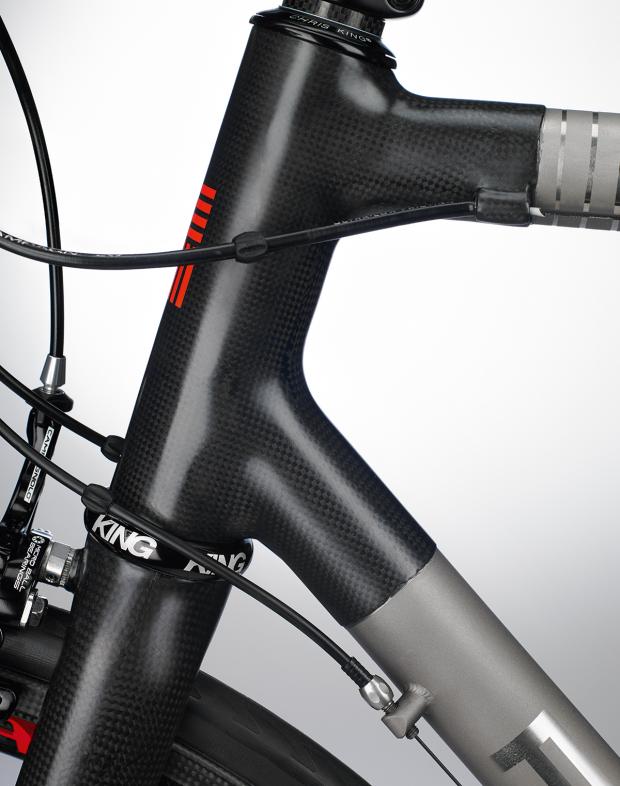Festka likes to think differently. That much is clear from the outlandish paintjobs on some of its bikes, with striking cubist motifs and loud colour contrasts that will leave you either shielding your eyes or reaching for your wallet. With the Doppler, however, Festka has shown that the brand’s innovation penetrates deeper than the lacquer. The Czech outfit has used different materials in a different way to create a very different bike.
It’s not the first time we’ve seen carbon and titanium combined on a frame – the likes of Independent Fabrication, Seven and Legend (featured last issue) have all done so – but Festka has inverted the concept. While those other brands use carbon tubes connected by titanium lugs, Festka has opted for titanium tubes bonded with carbon joints.

‘Others connect the carbon tubes with a titanium lug, which in our understanding of the material is the wrong way round,’ says Festka founder Ondřej Novotný. ‘Bikes need to be stiff in the head tube area and in the junctions, which is not easily achieved with titanium. That’s why we used the less stiff material [titanium] on the tubes where you need more compliance. Using carbon joints means the down tube and the top tube still have a really stiff connection to the head tube and the bottom bracket.’
Just as with the Festka One, production takes place entirely within the Czech Republic. The tubing is bought pre-made from Reynolds, but Festka then makes a few alterations. As well as mitring the tubes, Festka undertakes an unusual modification to the titanium (also used for its Asphalt frame) by slightly squashing the top tube. The reason is that an oval tube offers more lateral stiffness. Complementing this is the introduction of Doppler effect optical illusion-style vertical circles on the top tube, from which the bike takes its name.
The Doppler’s looks drew a number of compliments during my first ride, from other cyclists, pedestrians and even van drivers. And the aesthetics only get better when the frame is inspected in detail, especially the perfectly crafted titanium dropouts and the smoothness of the joints. It’s certainly a beautiful bike, but at this price it needs to deliver performance to match its looks if it is going to hold its own in a competitive market.
The Doppler effect

Ahead of my first ride on the Doppler I had a final ride on the Pinarello Dogma F8 before it was returned to the Italian mothership. The F8 has many merits, but it could be accused of being on the harsh side, so I was a little surprised when switching to the Doppler that it felt every bit as harsh as the F8, if not more so. Indeed, the Doppler moniker seemed appropriate if only because the bike rattled me into a state of visual distortion.
In fairness, that first impression was slightly skewed by the choice of saddle. The Selle San Marco Regale Carbon FX may be a good fit for a certain anatomy, but for me its flat shape and thin padding created a harsh and unforgiving feeling from the road. In fact, on my first long ride on the bike I returned home with noticeable pain in the backside.
Once I switched saddles the ride was more comfortable, but it still felt robust. Usually I favour a stiff ride as it assures me that little energy is being lost to flex and I’m getting the maximum rewards in terms of speed. Certainly the Doppler felt fast. The data seemed to support that impression too, as I recorded my fastest-ever time up my favoured local climb thanks to the bike’s solid build and low overall weight.

Despite the harsh response from the road, the Doppler was surprisingly sturdy over cobbles or gravel. It rumbled a bit, but the handling remained decisive, and I began to think that something about the construction of the bike meant that it was more disturbed by small imperfections in the road than by seriously rough surfaces. It isn’t a bike that glides, but it strides confidently over any terrain.
While I grew to appreciate the Doppler’s fast, racy persona, I began to wonder whether I would continue to enjoy it over many years of ownership. After all, this is the kind of bike that you would want to last you a lifetime and, if it were my bike, it may become a little overwhelming in two decades’ time when my race impulses have cooled down. But of course in the world of custom frames, nothing is set in stone.
‘Basically we can do any customisation that might be desired by a client. There is nothing pre-cooked,’ Novotný says. ‘What we did recently with some clients is that we made the standard build and we took it to the client to test the bike and asked him if he wanted to make it more stiff or if he was fine with it. It’s like using a tailor.’
Have it your way
The bike Festka presented to us for testing proved to be stiff and harsh, but I’m confident that Novotný could tune it accurately to any customer’s desire. Of course, that makes any review of limited relevance as no two bikes will be quite the same, but Novotný does nudge customers towards accepting the geometry he suggests.

‘We manage to persuade the customers to choose our standard geometries not because it’s easier for us but because it’s what we think works best,’ says Novotný. ‘Of course, we are open if a customer comes in and wants something different.’
My test ride showed that the geometry presented an excellent balance between an aggressive front-end position and a saddle drop that is manageable enough for all-day riding. Handling was also well-tuned, making the bike responsive on tight corners and fast descents.
While the Doppler is extremely impressive as it is, in order to become a bike I would want for life I would need to ask Festka to retain all the stiffness and speed while introducing elements of comfort into the ride – a tricky juggling act, but one that’s increasingly performed by top brands. Given the expertise of the team at Festka, I’m confident they could do exactly that.
Even as things stand, though, the Doppler is certainly an exceptional custom bike. It’s a thing of beauty, a product of a creative mind, and also, as a bonus, a bike that rides extremely well.
[“source-cyclist”]





